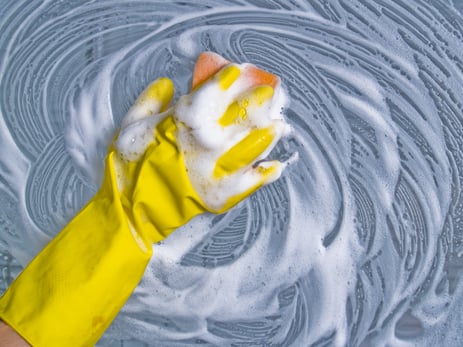
There are a number of lifestyle changes that you have to make when living with chronic obstructive pulmonary disease (COPD). Making these changes does not mean that your life will come to a standstill and have to live in a bubble; they just help you manage the symptoms of the disease a whole lot better. Patients with COPD must be extra careful in trying to prevent infections.
For a COPD patient, being infected with a virus, bacteria or any other infectious organism can make you more susceptible to getting lung infections, which can lead to breathing difficulties. When a patient with COPD has a lung infection, their shortness of breath, fatigue, coughing and other COPD symptoms can worsen very fast. The worsening of their symptoms is termed as having a COPD flare-up, also known as an acute exacerbation. This may require hospitalization of the patient for treatment. There is also a chance that when they get any type of respiratory infection, it could progress into pneumonia which can be life-threatening.
COPD patients need to practice good hygiene to prevent them from contracting infections. Good hygiene includes practices and habits which help maintain a person’s health, and also prevent diseases from spreading. Most infections and diseases are caused by bacteria and viruses which can be spread in various ways including;
- Inhaling germs that have contaminated the air.
- Touching or making contact with someone that is carrying the infectious germs.
- Touching or making contact with a surface that someone who has been infected has recently touched.
One of the places COPD patients get help with their management of COPD is a pulmonary rehabilitation program. It is a program consisting of education, exercise and support where COPD patients learn to breathe and function at the highest level possible. The patients get to work with a team of specialists who help to improve their physical condition. They also get to learn management techniques that will help them stay healthy and active long after they have completed the course.
As a part of the pulmonary rehabilitation program, patients learn how to practice good hygiene and reduce the risk of contracting infections. Some of the practices that they learn include;
- Cleaning their healthcare equipment properly.
- Learning how to properly wash their hands and how frequently it should be done.
- Good dental hygiene.
Cleaning Healthcare Equipment
People with COPD usually have a number of devices that help with their breathing, and if 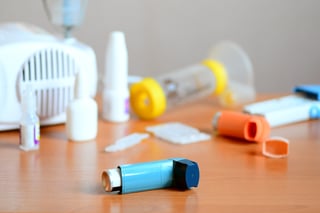 these devices are not cleaned regularly, they can harbor infectious organisms. Examples of some of the different equipment used include; spacers, oxygen therapy masks, nebulizers, nasal cannulas, inhalers, flutter valves and humidifiers.
these devices are not cleaned regularly, they can harbor infectious organisms. Examples of some of the different equipment used include; spacers, oxygen therapy masks, nebulizers, nasal cannulas, inhalers, flutter valves and humidifiers.
Inhalers for example, should be cleaned at least once each week. You may not see any build-up of the medicine on the inhaler, but it is important to keep it clean so that the build-up does not block the spray. The following steps should be used to clean an inhaler;
- Take the canister out of the actuator and remove the cap from the mouthpiece.
- Hold the actuator under the faucet, running warm water through it for about 30 seconds.
- Turn the actuator upside down and run warm water through the mouthpiece for about 30 seconds.
- Shake off as much water as you can from the actuator. Look into the mouthpiece to ensure any medicine build-up has completely been washed away. Should there still be some build-up, repeat steps 2 and 3.
- Let the actuator air-dry throughout the night.
- When the actuator is dry, put the protective cap back onto the mouthpiece, and the canister into the actuator making sure it fits firmly. Shake the inhaler well, remove the cap and spray the inhaler into the air (away from your face). If your inhaler has a counter, the number should reduce by one. Put the cap back on the mouthpiece.
If you need to use the inhaler before the actuator is completely dry, try to shake off as much water as you can from the actuator before use, then repeat the cleaning process. It is very important for the instructions for cleaning the equipment to be followed properly to prevent these organisms from developing within the devices.
Washing Your Hands
Washing your hands frequently and thoroughly using warm water and soap is a very simple yet effective way for COPD patients to avoid many types of infections. You should start with getting into the habit of washing your hands in the following situations;
- After visiting the restroom, even if you do not use it. Many germs reside in the bathoom
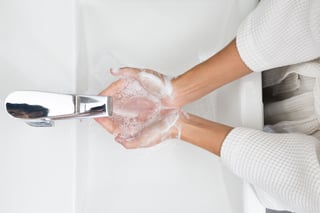
- Before and after the preparation of your food.
- When your hands are evidently dirty.
- After a meal, a drink or even a smoke.
- After touching another person.
- After coughing, nose-blowing or sneezing.
You should also be extra careful about hand washing if you spend time in the following areas; schools, workplaces, airports, malls, airplanes or other public transport systems, clinics, hospitals or even the doctor’s office.
Most people do not wash their hands correctly or even for as long as they should. Below is an outline of a good hand washing technique that you can use to ensure that your hands are properly cleaned.
- Run warm water and wet your hands.
- Apply some soap onto your hands and rub your hands vigorously for at least 20 seconds.
- Make sure to clean the back of your hands, between fingers, wrists and under the nails.
- Take a single-use paper towel while the water is still running from the faucet and dry your hands.
- Use another paper towel to turn off the faucet and open the bathroom door.
Hand sanitizers containing alcohol are a great addition to washing your hands, but should not be used as a replacement for hand washing.
Bathing with Portable Oxygen Concentrator
Your portable oxygen concentrator draws in ambient air and filters it through chambers 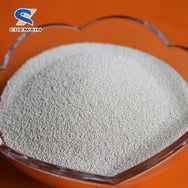 of medical sieve which blocks nitrogen and other elements leaving medical grade oxygen which it transport to you via your nasal cannula.
of medical sieve which blocks nitrogen and other elements leaving medical grade oxygen which it transport to you via your nasal cannula.
The sieve is a sand like substance which is very fine. As oxygen molecules are much smaller than others they are allowed to pass through while the others are trapped in the sieve and eventually ventilated out. The sieve deteriorates overtime and requires replacement. Humidity and temperature extremes are the two things that causes sieve to deteriorate the fastest.
The heat and humidity during a hot shower is bad for your concentrator. Leave your concentrator in another room while you bathe. If you must wear your concentrator to maintain oxygen levels while bathing, use a longer tube so that you can either leave it outside the door or near an open window as far away from the shower as possible.
Good Dental Hygiene
COPD patients are at a higher risk of getting oral diseases like periodontal disease, dry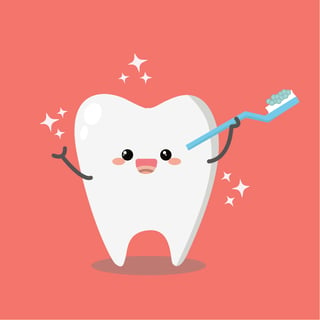 mouth, gingivitis and tooth decay. These conditions can lead to the worsening of COPD symptoms. Good oral hygiene may reduce the toll of the disease on your health.
mouth, gingivitis and tooth decay. These conditions can lead to the worsening of COPD symptoms. Good oral hygiene may reduce the toll of the disease on your health.
Brushing your teeth twice a day and flossing regularly will help get rid of harmful bacteria in your mouth and help protect your overall health. If you do not brush your teeth regularly, excess bacteria will build up along your gums, tongue and teeth. When it lingers for too long in your mouth, it can cause an infection along your teeth and gums increasing the inflammation in your mouth.
A recent study found that COPD patients that had poor dental hygiene were more likely to have COPD flare-ups. The types of poor dental health which were studied were;
- Large amounts of plaque on teeth.
- Having fewer teeth.
- Less time spent brushing teeth.
Follow these daily dental care tips for clean teeth and overall better oral hygiene;
- Always use a toothbrush with soft bristles. You can confirm which toothbrushes have soft bristles by looking for those labeled ‘soft’ or 'S' on the packaging. Using those labeled ‘medium’ for example, may lead to irritation along your gum line which can be a very sensitive area if you are diagnosed with COPD.
- When brushing your teeth, do not leave your tongue out. You should also brush your tongue since there are bacteria that can live on your tongue, and if not cleaned properly can lead to getting an infection.
- Hold your brush at a 45-degree angle to your gums when brushing your teeth. Make short tooth-wide strokes, moving back and forth. Many dentists agree that proper brushing should take at least two to three minutes. Brushing your teeth for too long can lead to sensitive teeth and receding gums.
- Replace your toothbrush every 3 to 4 months. Toothbrushes that are worn out do not do a great job at getting rid of food particles and bacteria.
- Use toothpaste containing fluoride because it strengthens the tooth enamel. The tooth enamel is the outer coating of your tooth. Fluoride helps protect you against tooth decay and gum disease by removing plaque.
- Floss: The use of toothpastes and toothbrushes to clean your teeth does not get rid of everything. Floss at least once every day in between each tooth. Flossing gets bacteria and food particles between your teeth before they can irritate your gums and form plaque.
You should visit your dentist every six months so that they can identify any problems that require immediate attention and also for them to make sure that your teeth and gums are healthy and free of decay and infection.
According to research, COPD patients that brush often and have regular dental visits experience fewer COPD exacerbations, compared to those who do not practice good oral hygiene or see their dentist regularly. The bottom line is taking good care of your oral hygiene may decrease your risk for COPD-related complications.



